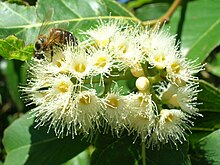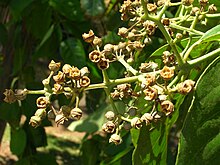
Nothofagus, also known as the southern beeches, is a genus of 43 species of trees and shrubs native to the Southern Hemisphere in southern South America and east and southeast Australia, New Zealand, New Guinea, and New Caledonia. The species are ecological dominants in many temperate forests in these regions. Some species are reportedly naturalised in Germany and Great Britain. The genus has a rich fossil record of leaves, cupules, and pollen, with fossils extending into the late Cretaceous period and occurring in Australia, New Zealand, Antarctica, and South America.

Eucalyptus pauciflora, commonly known as snow gum, cabbage gum or white sally, is a species of tree or mallee that is native to eastern Australia. It has smooth bark, lance-shaped to elliptical leaves, flower buds in clusters of between seven and fifteen, white flowers and cup-shaped, conical or hemispherical fruit. It is widespread and locally common in woodland in cold sites above 700 m (2,300 ft) altitude.
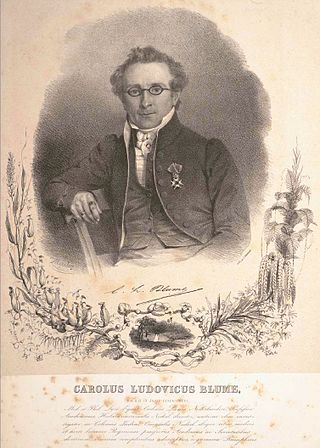
Charles Ludwig de Blume or Karl Ludwig von Blume was a German-Dutch botanist. The standard author abbreviation Blume is used to indicate this person as the author when citing a botanical name.

Nepenthes ventricosa is a tropical pitcher plant endemic to the Philippines, where it is a highland species, growing at an elevation of 1,000–2,000 metres (3,300–6,600 ft) above sea level. It has been recorded from the islands of Luzon, Panay, and Sibuyan. The pitchers are numerous, growing up to 20 centimetres (8 in) tall and ranging in colour from ivory white to red.

Nepenthes maxima, the great pitcher-plant, is a carnivorous pitcher plant species of the genus Nepenthes. It has a relatively wide distribution covering New Guinea, Sulawesi, and the Maluku Islands. It may also be present on Wowoni Island.
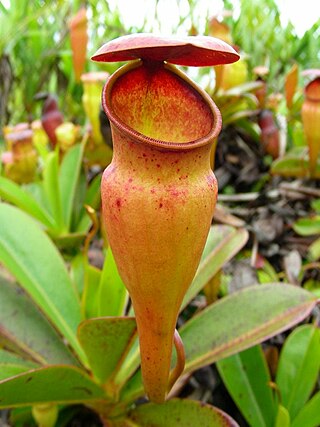
Nepenthes pervillei is the only pitcher plant found in the Seychelles, where it is endemic to the islands of Mahé and Silhouette. It grows in rocky areas near granitic mountain summits, its roots reaching deep into rock fissures. The species has an altitudinal range of 350–750 m above sea level. Like all members of the genus, N. pervillei is dioecious, having separate male and female plants.
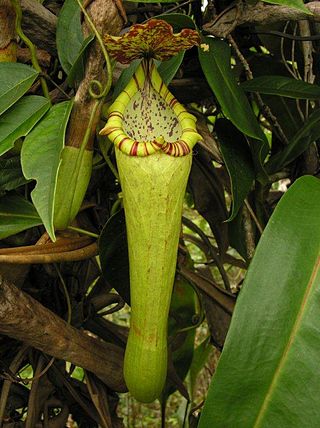
Nepenthes boschiana, or Bosch's pitcher-plant, is a tropical pitcher plant endemic to Borneo. It is most closely allied to N. faizaliana. Nepenthes borneensis is considered a synonym of this species. Nepenthes boschiana has no known natural hybrids. No valid forms or varieties have been described. Nepenthes boschiana belongs to the loosely defined "N. maxima complex", which also includes, among other species, N. chaniana, N. epiphytica, N. eymae, N. faizaliana, N. fusca, N. klossii, N. maxima, N. platychila, N. stenophylla, and N. vogelii.

Nepenthes madagascariensis is one of two Nepenthes pitcher plant species native to Madagascar, the other being N. masoalensis.
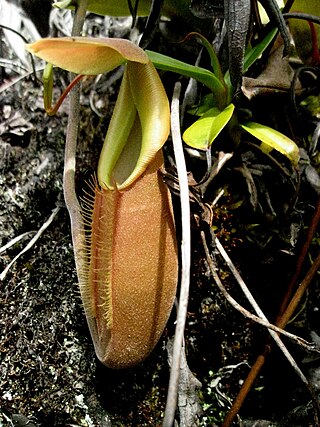
Nepenthes bongso is a tropical pitcher plant endemic to Sumatra, where it has an altitudinal distribution of 1000–2700 m above sea level. The specific epithet bongso refers to the Indonesian legend of Putri Bungsu, the spirit guardian of Mount Marapi.
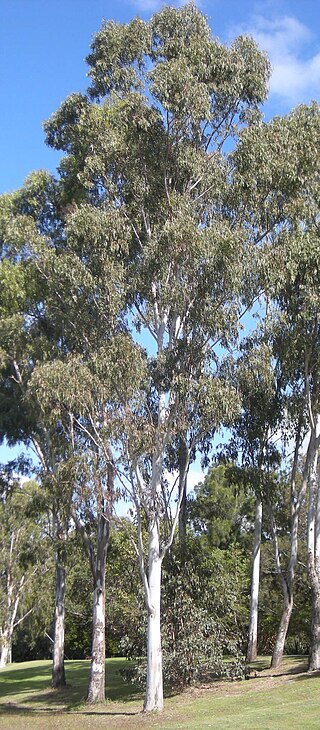
Eucalyptus tereticornis, commonly known as forest red gum, blue gum or red irongum, is a species of tree that is native to eastern Australia and southern New Guinea. It has smooth bark, lance-shaped to curved adult leaves, flower buds in groups of seven, nine or eleven, white flowers and hemispherical fruit.
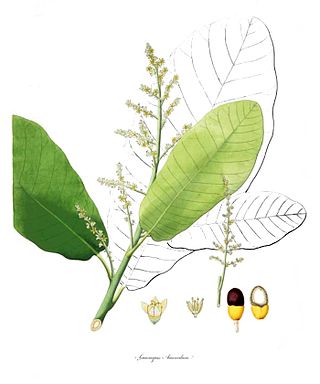
Semecarpus is a genus of plants in the family Anacardiaceae. It includes 87 species native to the Indian subcontinent, Indochina, Malesia, Taiwan, Papuasia, Queensland, and the South Pacific.

Dracontomelon is a genus of flowering plants in the family Anacardiaceae, growing mostly in SE Asia and the Pacific islands. The fruit may be used in local cuisine, especially as souring agents.

Eucalyptus rossii, commonly known as inland scribbly gum or white gum, is a species of small to medium-sized tree that is endemic to New South Wales and the Australian Capital Territory. It has smooth bark with insect scribbles, lance-shaped adult leaves, flower buds in groups of between nine and fifteen, white flowers and hemispherical or shortened spherical fruit.

Ligustrum robustum grows as a shrub or small tree up to 10 m (30 ft) tall though old specimens of more than a hundred years have been observed with a height of 15 m (50 ft). The fruit of the shrub is an ellipsoid berry, bluish-purple when fully ripe, 7–10 mm (0.28–0.39 in) × 4–5 mm (0.16–0.20 in).

Trema micranthum, the Jamaican nettletree or capulin, is a plant species native to warmer parts of the Western Hemisphere. It has been reported from Mexico, Central America, tropical South America, the Virgin Islands, Jamaica, Cuba, Hispaniola, Puerto Rico, and southern Florida.

Jasminanthes is a plant genus in the family Apocynaceae, first described as a genus in 1850. It is native to China, Laos, Thailand and Vietnam.
- Jasminanthes chunii(Tsiang) W.D. Stevens & P.T. Li - Guangdong, Guangxi, Hunan
- Jasminanthes laotica Y.H. Tan & H.B. Ding - Laos
- Jasminanthes mucronata(Blanco) W.D. Stevens & P.T. Li - Fujian, Guangdong, Guangxi, Guizhou, Hunan, Sichuan, Taiwan, Zhejiang
- Jasminanthes pilosa(Kerr) W.D. Stevens & P.T. Li - Guangxi, Yunnan, Thailand, Vietnam
- Jasminanthes saxatilis(Tsiang & P.T. Li) W.D. Stevens & P.T. Li - Guangxi, Yunnan
- Jasminanthes tuyetanhiae T.B.Tran & Rodda - Vietnam
- Jasminanthesxuanlienensis T.B Tran & Rodda - Vietnam

Phaius amboinensis, commonly known as Arnhem Land swamp orchid, is a plant in the orchid family and is native to areas from Malesia through to New Guinea, Australia and islands in the Pacific Ocean. It is an evergreen, terrestrial herb with up to eight pleated leaves and up to twenty, relatively large white flowers with a yellow labellum. It grows in wet, shady forests.
Tainia trinervis, commonly known as the ribbon orchid, is an evergreen, terrestrial plant with crowded pseudobulbs, each with a single smooth, shiny leaf and up to fourteen greenish to yellowish flowers with red or purplish stripes in the middle. It is found in tropical Southeast Asia, New Guinea and northern Australia.
Dendrobium insigne, commonly known as the mangrove tartan orchid, is a species of epiphytic or lithophytic orchid native to New Guinea and Indonesia. It has crowded, cane-like stems with many leaves arranged in two vertical rows, and short-lived yellow and red flowers in groups of two or three.
Memecylon pauciflorum is a tree species in the Melastomataceae family. It grows as a tree or shrub in northern Australia and tropical and subtropical Asia. An understorey species typically, it grows in a variety of communities. The possum Petropseudes dahli uses this species as one of their scent-marking sites. It is a host to a number of funguses. People in Australia and in Thailand use the plant in folk medicine, though no efficacy has been demonstrated.


